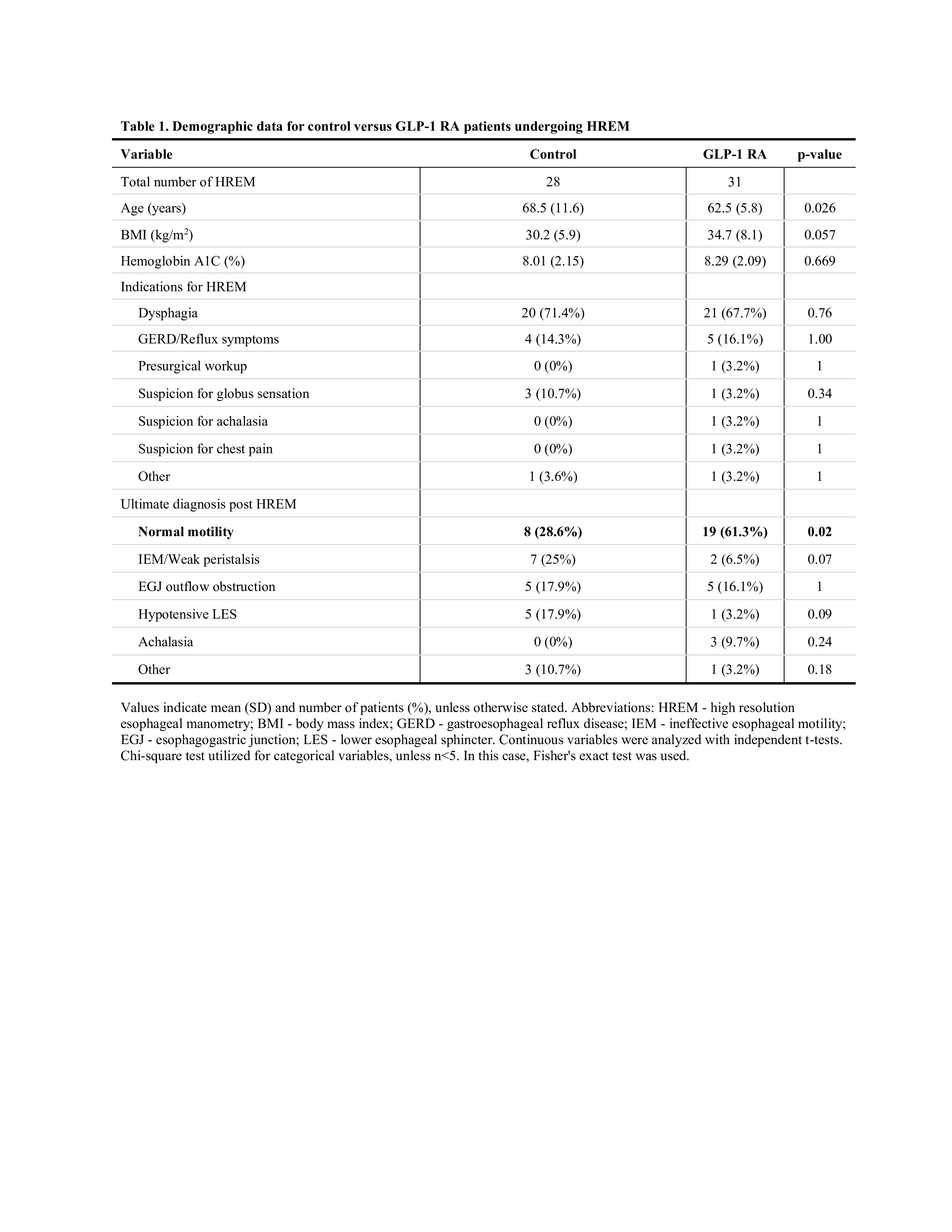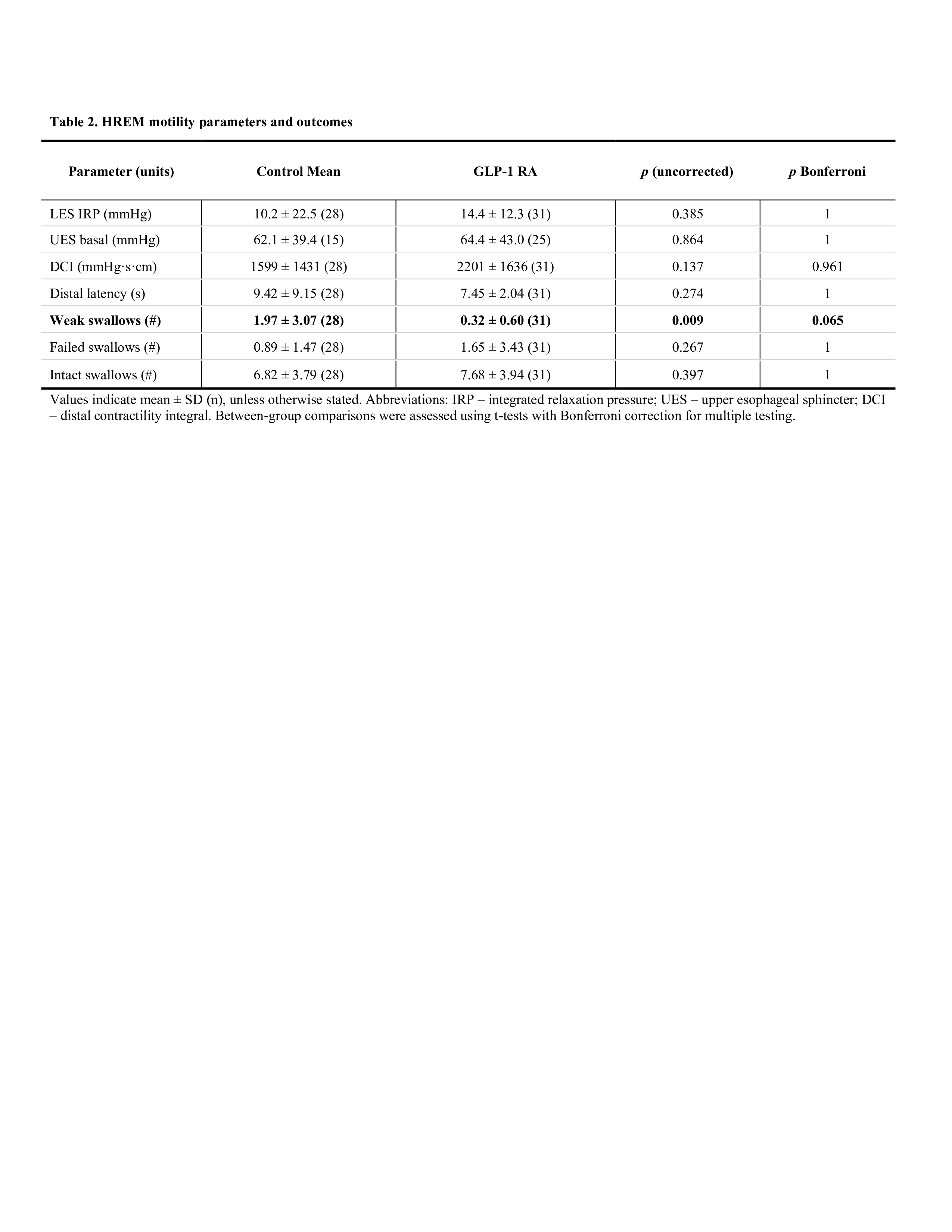Tuesday Poster Session
Category: Esophagus
P4874 - Examining the Effects of GLP-1 Receptor Agonist Therapy on Esophageal Motility Through High Resolution Esophageal Manometry (HREM)
Tuesday, October 28, 2025
10:30 AM - 4:00 PM PDT
Location: Exhibit Hall

Kanisha Bahierathan, BS (she/her/hers)
Case Western Reserve University School of Medicine
Cleveland, OH
Presenting Author(s)
Benjamin D. Liu, MD1, Kanisha Bahierathan, BS2, Karissa DiPierro, BS2, Ye Tian, PhD3, Yasir Tarabichi, MD4, Hannah Hill, MSc5, Ronnie Fass, MD, MACG6, Gengqing Song, MD7
1Department of Internal Medicine, Metrohealth Medical Center, Cleveland, OH; 2Case Western Reserve University School of Medicine, Cleveland, OH; 3Cleveland Institute for Computational Biology, Case Western Reserve University, Cleveland, OH; 4Center for Clinical Informatics Research and Education, MetroHealth Medical Center, Cleveland, OH; 5Population Health and Equity Research Institute, Metrohealth Medical Center, Cleveland, OH; 6Division of Gastroenterology and Hepatology, Metrohealth Medical Center, Orange, OH; 7Division of Gastroenterology and Hepatology, Metrohealth Medical Center, Cleveland, OH
Introduction: Glucagon-like peptide-1 receptor agonists (GLP-1 RAs) are medications used in the treatment of obesity and type 2 diabetes. They cause delayed gastric emptying and increase gastrointestinal side effects, however their impact on esophageal motility is not well understood. We aimed to determine if GLP-1 RAs have a significant effect on esophageal motility compared to, equivalent, second-line diabetes medications (OSLT2DM).
Methods: We queried the Metrohealth database using the TriNetX network to identify patients who had T2DM or who had a BMI ≥ 27 (2006-2025) who initiated Cohort 1) GLP-1 RA or Cohort 2) OSLT2DM, excluding esophageal motility disorders and major upper abdominal surgery. We extracted high-resolution esophageal manometry (HREM) reports with dates of prescription initiation and refills. For Cohort 1, reports were extracted during active GLP-1 RA use; for Cohort 2, from OSLT2DM initiation until GLP-1 RA initiation or date of query. Patient demographics, BMI, A1c, HREM report indication, diagnoses and metrics were extracted. Statistical comparisons were done using t-tests, with Bonferroni correction for multiple testing.
Results: Cohort 1 had 31 patients while Cohort 2 had 28. Cohort 1 average age was 62.5 ± 5.8 years, with an average BMI of 34.7 ± 8.1 kg/m², and an average A1c of 8.29 ± 2.09%. Cohort 2 had an average age of 68.5 ± 11.6 years, with an average BMI of 30.2 ± 5.9 kg/m², and an average A1c of 8.01 ± 2.15%. Overall, 67.7% of Cohort 1 and 71.4% of Cohort 2 underwent HREM for dysphagia while 16.1% of Cohort 1 and 14.3% of Cohort 2 were evaluated for reflux. Normal motility was significantly more common in Cohort 1 (61.3% vs. 28.6%, p = 0.02) while ineffective esophageal motility was more prevalent in Cohort 2 (6.5% vs 25%, p = 0.07), though not statistically significant. HREM data showed no significant differences in LES integrated relaxation pressure (14.4 ± 12.3 vs. 10.2 ± 22.5, p = 0.385), distal latency (7.45 ± 2.04 vs. 9.42 ± 9.15, p = 0.274) and distal contractile integral (2201 ± 1636 vs. 1599 ± 1431, p = 0.137). Weak swallows were more common in the control group (0.32 ± 0.60 vs. 1.97 ± 3.07, p = 0.009, corrected p = 0.065), though not significant after Bonferroni correction.
Discussion: Our findings indicate that GLP-1 RA exposure does not significantly affect esophageal motility or sphincter pressures. Despite their association with GERD, GLP-1 RAs likely act via delayed gastric emptying rather than affecting esophageal motility, warranting further research.

Figure: Values indicate mean (SD) and number of patients (%), unless otherwise stated. Abbreviations: HREM - high resolution esophageal manometry; BMI - body mass index; GERD - gastroesophageal reflux disease; IEM - ineffective esophageal motility; EGJ - esophagogastric junction; LES - lower esophageal sphincter. Continuous variables were analyzed with independent t-tests. Chi-square test utilized for categorical variables, unless n <5. In this case, Fisher's exact test was used.

Figure: Values indicate mean ± SD (n), unless otherwise stated. Abbreviations: IRP – integrated relaxation pressure; UES – upper esophageal sphincter; DCI – distal contractility integral. Between-group comparisons were assessed using t-tests with Bonferroni correction for multiple testing.
Disclosures:
Benjamin Liu indicated no relevant financial relationships.
Kanisha Bahierathan indicated no relevant financial relationships.
Karissa DiPierro indicated no relevant financial relationships.
Ye Tian indicated no relevant financial relationships.
Yasir Tarabichi indicated no relevant financial relationships.
Hannah Hill indicated no relevant financial relationships.
Ronnie Fass: BrainTree Labs/Sebela – Consultant. Carnot – Speaker. Daewoong – Consultant, Speaker. dexcal – Consultant. Megalab – Speaker. Phathom Pharmaceuticals – Advisory Committee/Board Member, Consultant.
Gengqing Song indicated no relevant financial relationships.
Benjamin D. Liu, MD1, Kanisha Bahierathan, BS2, Karissa DiPierro, BS2, Ye Tian, PhD3, Yasir Tarabichi, MD4, Hannah Hill, MSc5, Ronnie Fass, MD, MACG6, Gengqing Song, MD7. P4874 - Examining the Effects of GLP-1 Receptor Agonist Therapy on Esophageal Motility Through High Resolution Esophageal Manometry (HREM), ACG 2025 Annual Scientific Meeting Abstracts. Phoenix, AZ: American College of Gastroenterology.
1Department of Internal Medicine, Metrohealth Medical Center, Cleveland, OH; 2Case Western Reserve University School of Medicine, Cleveland, OH; 3Cleveland Institute for Computational Biology, Case Western Reserve University, Cleveland, OH; 4Center for Clinical Informatics Research and Education, MetroHealth Medical Center, Cleveland, OH; 5Population Health and Equity Research Institute, Metrohealth Medical Center, Cleveland, OH; 6Division of Gastroenterology and Hepatology, Metrohealth Medical Center, Orange, OH; 7Division of Gastroenterology and Hepatology, Metrohealth Medical Center, Cleveland, OH
Introduction: Glucagon-like peptide-1 receptor agonists (GLP-1 RAs) are medications used in the treatment of obesity and type 2 diabetes. They cause delayed gastric emptying and increase gastrointestinal side effects, however their impact on esophageal motility is not well understood. We aimed to determine if GLP-1 RAs have a significant effect on esophageal motility compared to, equivalent, second-line diabetes medications (OSLT2DM).
Methods: We queried the Metrohealth database using the TriNetX network to identify patients who had T2DM or who had a BMI ≥ 27 (2006-2025) who initiated Cohort 1) GLP-1 RA or Cohort 2) OSLT2DM, excluding esophageal motility disorders and major upper abdominal surgery. We extracted high-resolution esophageal manometry (HREM) reports with dates of prescription initiation and refills. For Cohort 1, reports were extracted during active GLP-1 RA use; for Cohort 2, from OSLT2DM initiation until GLP-1 RA initiation or date of query. Patient demographics, BMI, A1c, HREM report indication, diagnoses and metrics were extracted. Statistical comparisons were done using t-tests, with Bonferroni correction for multiple testing.
Results: Cohort 1 had 31 patients while Cohort 2 had 28. Cohort 1 average age was 62.5 ± 5.8 years, with an average BMI of 34.7 ± 8.1 kg/m², and an average A1c of 8.29 ± 2.09%. Cohort 2 had an average age of 68.5 ± 11.6 years, with an average BMI of 30.2 ± 5.9 kg/m², and an average A1c of 8.01 ± 2.15%. Overall, 67.7% of Cohort 1 and 71.4% of Cohort 2 underwent HREM for dysphagia while 16.1% of Cohort 1 and 14.3% of Cohort 2 were evaluated for reflux. Normal motility was significantly more common in Cohort 1 (61.3% vs. 28.6%, p = 0.02) while ineffective esophageal motility was more prevalent in Cohort 2 (6.5% vs 25%, p = 0.07), though not statistically significant. HREM data showed no significant differences in LES integrated relaxation pressure (14.4 ± 12.3 vs. 10.2 ± 22.5, p = 0.385), distal latency (7.45 ± 2.04 vs. 9.42 ± 9.15, p = 0.274) and distal contractile integral (2201 ± 1636 vs. 1599 ± 1431, p = 0.137). Weak swallows were more common in the control group (0.32 ± 0.60 vs. 1.97 ± 3.07, p = 0.009, corrected p = 0.065), though not significant after Bonferroni correction.
Discussion: Our findings indicate that GLP-1 RA exposure does not significantly affect esophageal motility or sphincter pressures. Despite their association with GERD, GLP-1 RAs likely act via delayed gastric emptying rather than affecting esophageal motility, warranting further research.

Figure: Values indicate mean (SD) and number of patients (%), unless otherwise stated. Abbreviations: HREM - high resolution esophageal manometry; BMI - body mass index; GERD - gastroesophageal reflux disease; IEM - ineffective esophageal motility; EGJ - esophagogastric junction; LES - lower esophageal sphincter. Continuous variables were analyzed with independent t-tests. Chi-square test utilized for categorical variables, unless n <5. In this case, Fisher's exact test was used.

Figure: Values indicate mean ± SD (n), unless otherwise stated. Abbreviations: IRP – integrated relaxation pressure; UES – upper esophageal sphincter; DCI – distal contractility integral. Between-group comparisons were assessed using t-tests with Bonferroni correction for multiple testing.
Disclosures:
Benjamin Liu indicated no relevant financial relationships.
Kanisha Bahierathan indicated no relevant financial relationships.
Karissa DiPierro indicated no relevant financial relationships.
Ye Tian indicated no relevant financial relationships.
Yasir Tarabichi indicated no relevant financial relationships.
Hannah Hill indicated no relevant financial relationships.
Ronnie Fass: BrainTree Labs/Sebela – Consultant. Carnot – Speaker. Daewoong – Consultant, Speaker. dexcal – Consultant. Megalab – Speaker. Phathom Pharmaceuticals – Advisory Committee/Board Member, Consultant.
Gengqing Song indicated no relevant financial relationships.
Benjamin D. Liu, MD1, Kanisha Bahierathan, BS2, Karissa DiPierro, BS2, Ye Tian, PhD3, Yasir Tarabichi, MD4, Hannah Hill, MSc5, Ronnie Fass, MD, MACG6, Gengqing Song, MD7. P4874 - Examining the Effects of GLP-1 Receptor Agonist Therapy on Esophageal Motility Through High Resolution Esophageal Manometry (HREM), ACG 2025 Annual Scientific Meeting Abstracts. Phoenix, AZ: American College of Gastroenterology.

